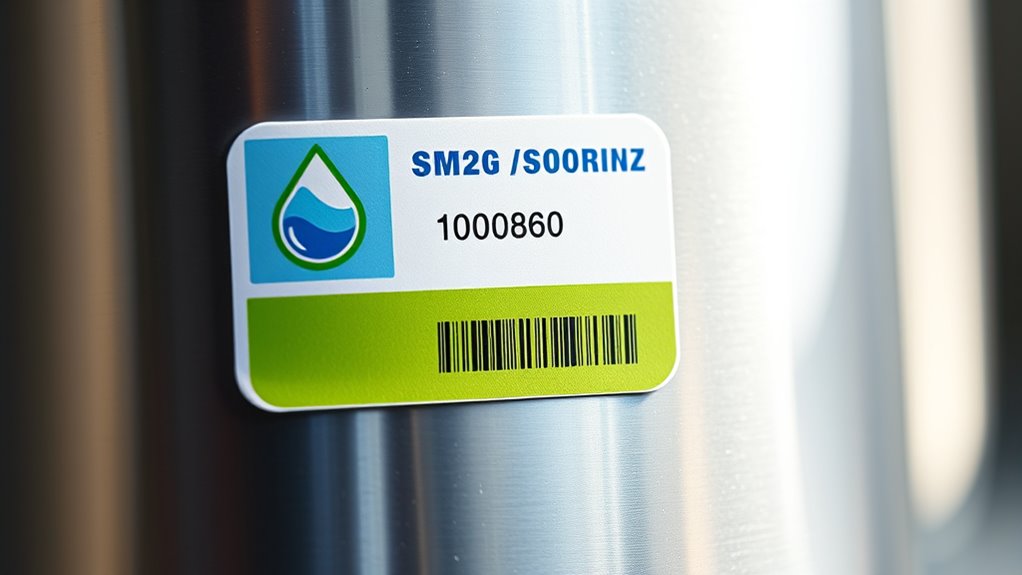Hydrogen certification labels show you that a product meets safety, sustainability, and quality standards, often aligned with international norms like ISO/TC 197. They indicate compliance with emission thresholds, such as low or zero-carbon targets, and confirm that safety tests and audits have been passed. These labels also identify equipment readiness and facilitate market trust. To understand what these labels truly mean and how they impact your projects, explore the detailed principles and standards behind them.
Key Takeaways
- Labels indicate compliance with safety, regulatory, and sustainability standards, ensuring hydrogen products meet domestic and international norms.
- Certification labels reflect lifecycle emission thresholds, such as green hydrogen standards, promoting low-carbon production.
- They verify safety and performance, including tank integrity and equipment safety for hydrogen applications.
- Labels demonstrate adherence to national certification processes involving third-party audits and on-site inspections.
- Certification fosters market trust, facilitates legal compliance, and signals sustainable, high-quality hydrogen to consumers.
Understanding Hydrogen Certification Labels and Their Purpose
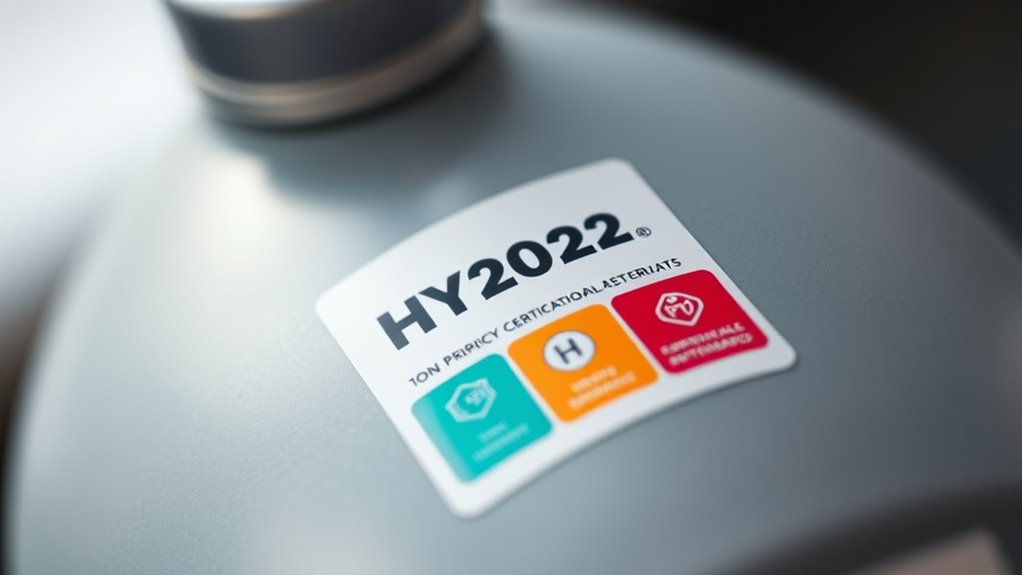
Have you ever wondered what hydrogen certification labels really mean and why they matter? These labels serve to show that equipment meets specific safety, regulatory, and sustainability standards. They help you identify products that are compliant with international norms, like ISO/TC 197 standards, and national laws. Certification labels also signal that third-party bodies have audited and validated the equipment, ensuring safety and quality. They can highlight sustainability attributes, such as green or low-carbon hydrogen, making it easier for consumers to choose environmentally friendly options. Certification labels also support market differentiation, helping products stand out as safer or more sustainable. Ultimately, they provide confidence that the equipment meets legal requirements and safety standards, fostering trust and facilitating international trade. Green Hydrogen Certification Standard (CMS 70) is an example of such a label that ensures traceability and low emissions in hydrogen production. Additionally, these labels often include traceability features that enable tracking the origin and production methods of hydrogen, further assuring consumers of its sustainability and compliance.
Key Principles Behind Certification Schemes

Understanding emission thresholds and standards is vital to guarantee hydrogen meets sustainability goals, while the certification process and verification maintain trust and accuracy. You need clear procedures for evaluating compliance and independent audits to verify claims. Certification schemes are categorized as customized, unsuitable for demonstrating target compliance for RFNBOs. Additionally, establishing consistent measurement methods ensures comparability across different schemes and enhances credibility. By focusing on these key principles, certification schemes can effectively support transparent and reliable hydrogen markets.
Emission Thresholds and Standards
Emission thresholds and standards form the foundation of effective certification schemes for domestic hydrogen. These thresholds typically set a greenhouse gas (GHG) emission limit around 4.0 kg CO2eq per kg of hydrogen, based on lifecycle “well-to-gate” emissions. Some standards, like the Green Hydrogen Standard, adopt stricter limits, such as under 1 kg CO2eq, with others like the U.S. Inflation Reduction Act aiming for below 0.45 kg CO2eq. Certification grades are assigned based on measured emissions, often using a tiered system to reflect emission intensity. Accurate accounting includes production, processing, and transportation, ensuring exhaustive lifecycle coverage. Thresholds are designed to match domestic conditions and align with international trends, facilitating harmonization and market credibility. Track development is crucial for establishing reliable and consistent certification benchmarks.
Certification Process and Verification
The certification process and verification are built on key principles that guarantee reliability, transparency, and consistency in certifying domestic hydrogen. These principles ensure stakeholders can trust the certification outcomes and that standards are upheld throughout the supply chain. Governance sets the framework, involving regulatory bodies, industry players, and third-party organizations to maintain alignment with national and international standards. Assessment processes include reviewing technical documents, conducting on-site inspections, and evaluating manufacturing quality. Verification methods encompass rigorous testing, ongoing monitoring, and audits to confirm compliance. Third-party certification bodies provide impartial assessments, boosting credibility and market acceptance. Certification levels—concept, project, and lifecycle—cover different stages, ensuring continuous conformity and adaptation to evolving standards. Incorporating risk assessment practices helps identify vulnerabilities and strengthen the integrity of certification schemes.
The Role of TÜV NORD H2-Readiness Label in Hydrogen Projects
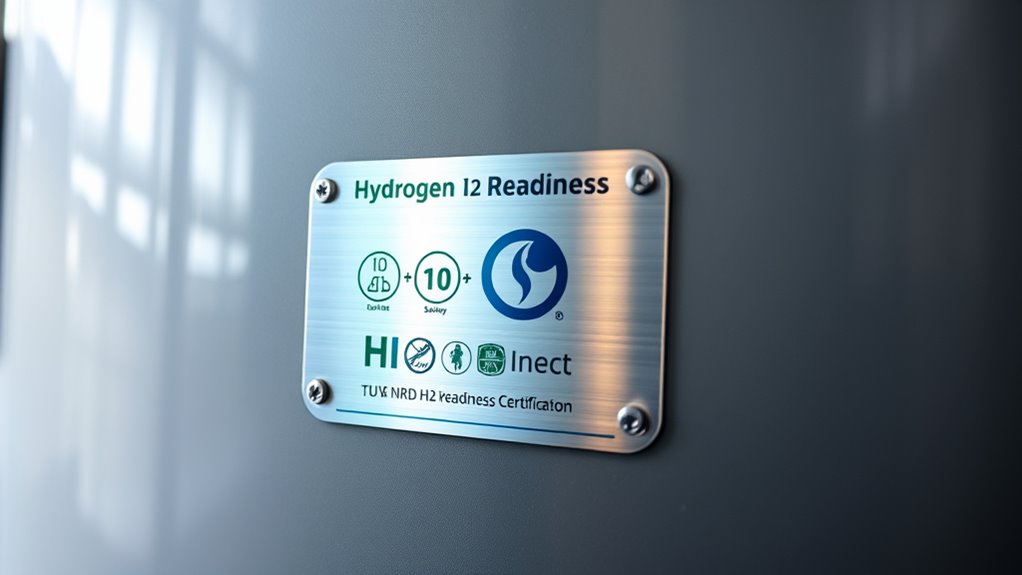
The TÜV NORD H2-Readiness Label plays an essential role in validating whether hydrogen projects are prepared for safe and effective application across planning, production, storage, transport, and use stages. It offers objective, trustworthy proof that your project or product meets hydrogen-specific safety and performance standards. You can obtain certification at different points: during planning to demonstrate initial compliance, after project completion to confirm implementation, or for individual products to verify suitability for hydrogen applications. The certification criteria are based on relevant norms and a dedicated hydrogen catalogue, ensuring tailored and reliable assessments. This label not only supports compliance but also boosts confidence among stakeholders, helping you reduce risks, increase market acceptance, and facilitate the smooth integration of hydrogen technologies into your project. Certification provides a clear and credible indication of readiness that can be recognized by partners, regulators, and customers alike. Additionally, adhering to these standards can help align your project with existing safety regulations, which are crucial for successful deployment and acceptance in the market.
GHG Emission Standards for Label Eligibility
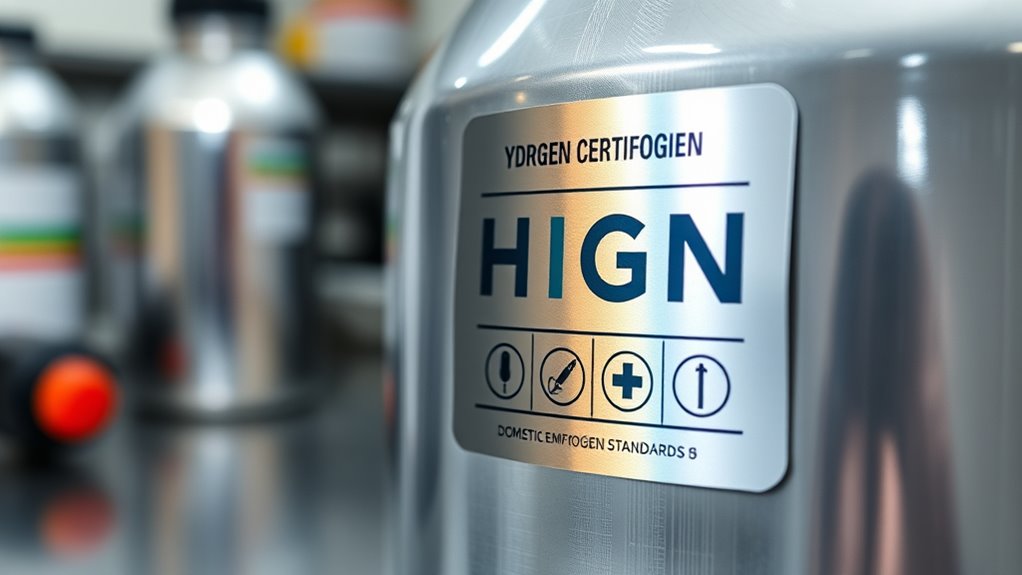
Establishing GHG emission standards for hydrogen labels requires setting clear, measurable thresholds that differentiate low-carbon options from conventional fossil-based hydrogen. Certification schemes define specific GHG intensity limits, such as kg CO2eq per kg of H2, to determine eligibility. These thresholds often reflect international climate goals and may include life cycle emissions from feedstock extraction, production, and transportation. Labels categorize hydrogen types—green, blue, etc.—based on emissions profiles. To qualify, hydrogen must meet substantially lower emissions than traditional fossil fuels. These standards are aligned with national legislation and ISO methodologies, ensuring consistency. Verification involves third-party validation, ongoing monitoring, and transparent reporting. This framework supports market differentiation and policy incentives, encouraging the production and use of genuinely low-GHG hydrogen options. Incorporating wall organization systems can also facilitate tracking and demonstrating compliance with these standards.
Ensuring Safety Through Equipment Certification
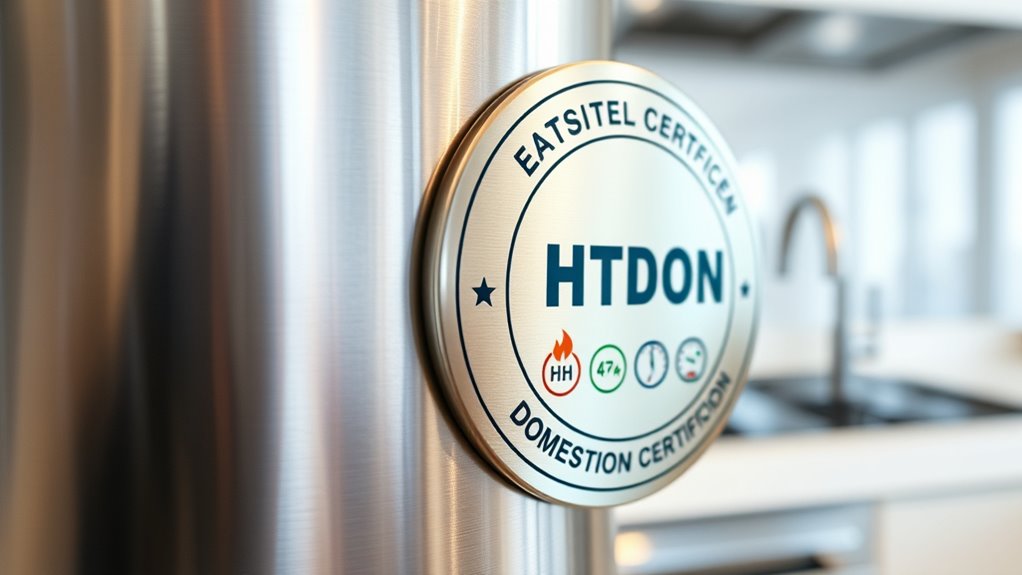
Ensuring safety through equipment certification is essential for the reliable and secure operation of hydrogen technologies. You need to follow strict codes and standards, like the International Fire Code, NFPA 2, and ISO standards, to confirm equipment safety. Certification involves testing and evaluation, such as hydraulic proof tests, material assessments, and pressure cycle tests, to verify tank integrity and durability. Certification marks from organizations like UL or TÜV SÜD validate that products meet safety criteria and undergo ongoing factory audits. Design standards and proper material selection guarantee manufacturing quality and system safety. H2-Readiness certification by organizations like TÜV SÜD ensures that hydrogen equipment meets specific safety and performance criteria for future hydrogen applications. Additionally, understanding certification processes and the criteria involved can help stakeholders ensure compliance and safety. By adhering to these processes, you can trust that hydrogen equipment performs safely under normal and extreme conditions, reducing risks and supporting safe hydrogen use in your applications.
Stakeholders and Governance of Certification Programs
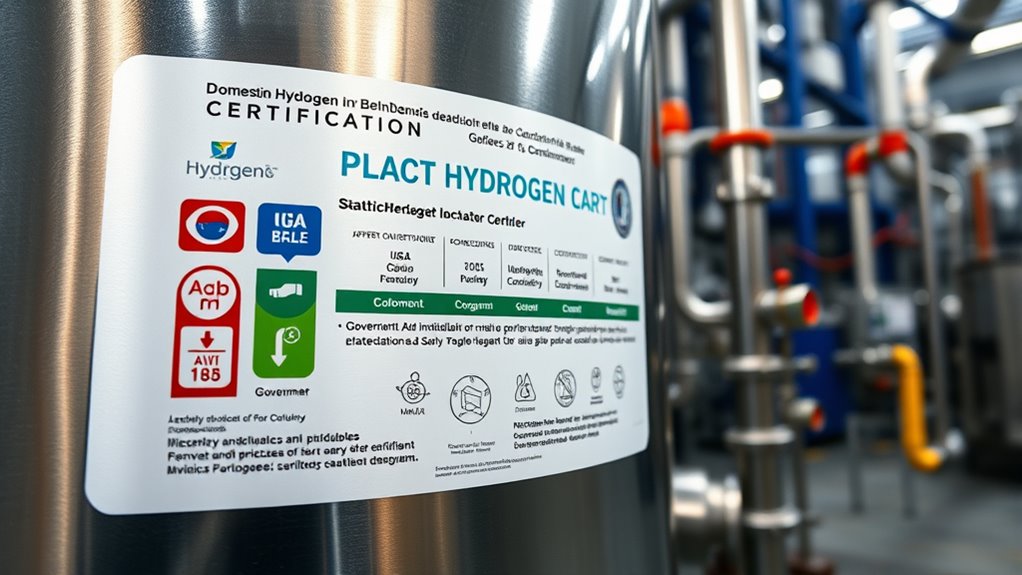
Stakeholders play a crucial role in shaping the governance of hydrogen certification programs by providing a collaborative platform where industry players, policymakers, and technical experts work together. This environment enables diverse voices to influence certification schemes, guarantee they remain relevant, and address regulatory gaps. Through working groups, stakeholders propose improvements and build consensus to influence legislation and promote industry growth. Your participation helps create credible, trustworthy systems that facilitate market access and incentives. The CertifHy Stakeholder Platform specifically fosters an interactive environment for industry collaboration and knowledge sharing. – Industry representatives, including hydrogen producers and carriers – Policymakers and regulators shaping legislation – Technical experts developing certification standards – Environmental organizations aligning with climate goals – Market facilitators ensuring transparency and compliance. Additionally, incorporating Cultural Intelligence principles can enhance stakeholder engagement by fostering mutual understanding and effective communication across diverse sectors and regions.
Benefits of Recognized Certification for Market Participants
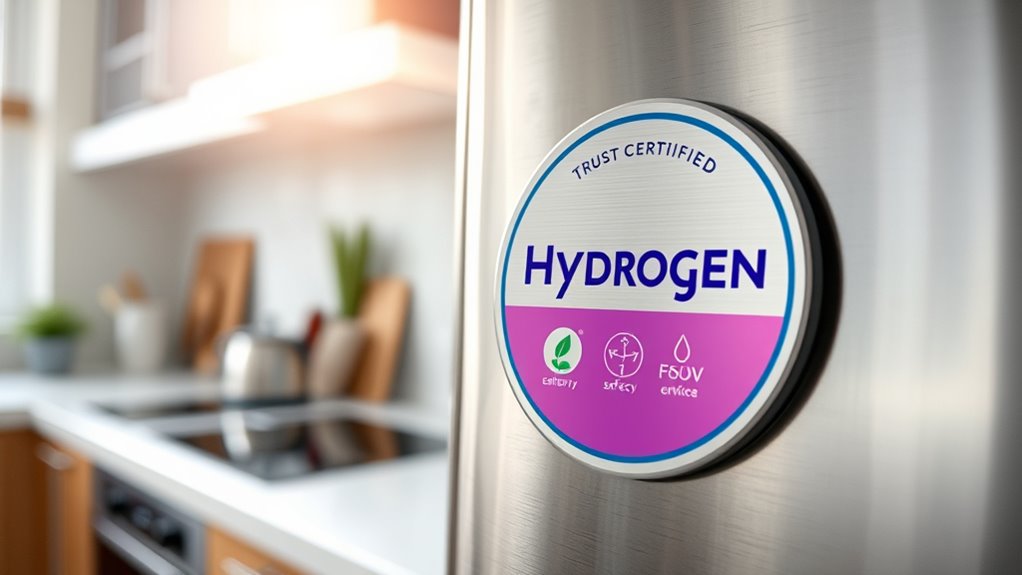
Recognized certification plays a vital role in helping market participants access the full potential of hydrogen technologies. It demonstrates compliance with regulations like the EU’s Renewable Energy Directive, making it easier to meet legal requirements. Certification also boosts market and public acceptance by verifying safety and credibility, which can attract consumers and investors. It supports project bankability and investment by providing assurance of sustainability and low-carbon properties, fostering trust among stakeholders. Additionally, certification enhances supply chain transparency, confirming that hydrogen is produced sustainably. For you, this means easier entry into markets, better competitiveness, and stronger alignment with climate and regulatory goals. Ultimately, recognized certification helps you build credibility, attract funding, and position your hydrogen products as trusted, sustainable solutions. Incorporating quality standards ensures consistent safety and performance across the industry.
Frequently Asked Questions
How Do Certification Labels Influence Hydrogen Market Prices and Trading?
Certification labels directly influence hydrogen market prices and trading by verifying sustainability attributes, which helps you identify greener options. They enable trust and transparency, making it easier to buy and sell certified hydrogen across borders without re-verification. Labels also facilitate incentives like subsidies and regulatory benefits, lowering costs for producers. Overall, they shape demand, encourage cleaner production, and promote market growth by providing clear signals to all participants.
Can Certification Labels Be Transferred Between Different Hydrogen Projects or Regions?
So, you think certification labels can easily travel from one hydrogen project or region to another? Think again. They’re typically project-specific and region-bound, meaning you can’t just move a certificate across borders or projects without hurdles. Mutual recognition agreements and standardization are still works in progress. Without them, labels stay tied to their original projects, making cross-region transfer a frustrating, often impossible, dream—despite what you might hope.
What Are the Costs Associated With Obtaining and Maintaining Certification Labels?
You’ll face several costs when obtaining and maintaining certification labels. Initially, you’ll pay application fees, conduct documentation and verification audits, and possibly upgrade infrastructure to meet domestic content standards. Ongoing expenses include periodic recertification, maintaining detailed records, and staff time for compliance checks. Plus, you must stay updated on evolving regulations, which can increase legal and consultation costs, all while ensuring continuous supplier compliance to avoid penalties.
How Often Are Hydrogen Certification Standards Reviewed and Updated?
You might be surprised to learn that hydrogen certification standards are reviewed and updated roughly every 2 to 3 years. This frequent review cycle guarantees standards stay aligned with technological advances, new policies, and market demands. During these updates, industry feedback, innovations, and regulatory changes are considered, often leading to refinements. This ongoing process helps maintain credibility, international harmonization, and relevance in the rapidly evolving hydrogen economy.
Are There Penalties for Non-Compliance With Certification Requirements?
You should know that there are penalties if you don’t follow certification requirements. If you obtain certification through fraud or fail to meet standards, it can be revoked. Not reporting required information or misstatements on domestic content can lead to fines, sometimes up to $5,000 or 10% of the claim. Non-compliance with verification and reporting obligations can also disqualify your credits, risking financial and certification penalties.
Conclusion
Think of hydrogen certification labels as a lighthouse guiding you through a foggy sea of options. They illuminate which hydrogen is truly green, safe, and reliable, helping you make confident decisions. With clear standards and trusted certifications, you’ll navigate the complex waters of the hydrogen market with ease, avoiding pitfalls and steering toward a sustainable future. Remember, these labels are your beacon, ensuring your journey toward clean energy stays on course.
I’m Theodore, and I love tiny houses. In fact, I’m the author of Tiny House 43, a book about tiny houses that are also tree houses. I think they’re magical places where imaginations can run wild and adventures are just waiting to happen.
While tree houses are often associated with childhood, they can be the perfect adult retreat. They offer a cozy space to relax and unwind, surrounded by nature. And since they’re typically built on stilts or raised platforms, they offer stunning views that traditional homes simply can’t match.
If you’re looking for a unique and romantic getaway, a tree house tiny house might just be the perfect option.
